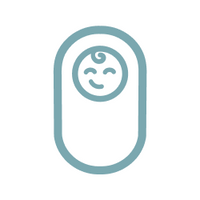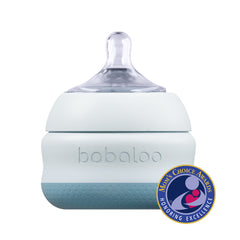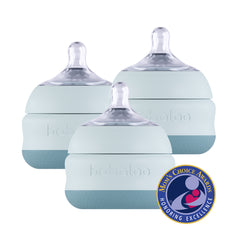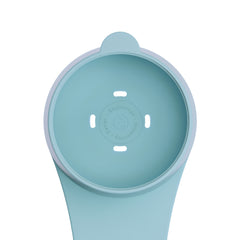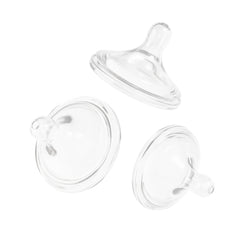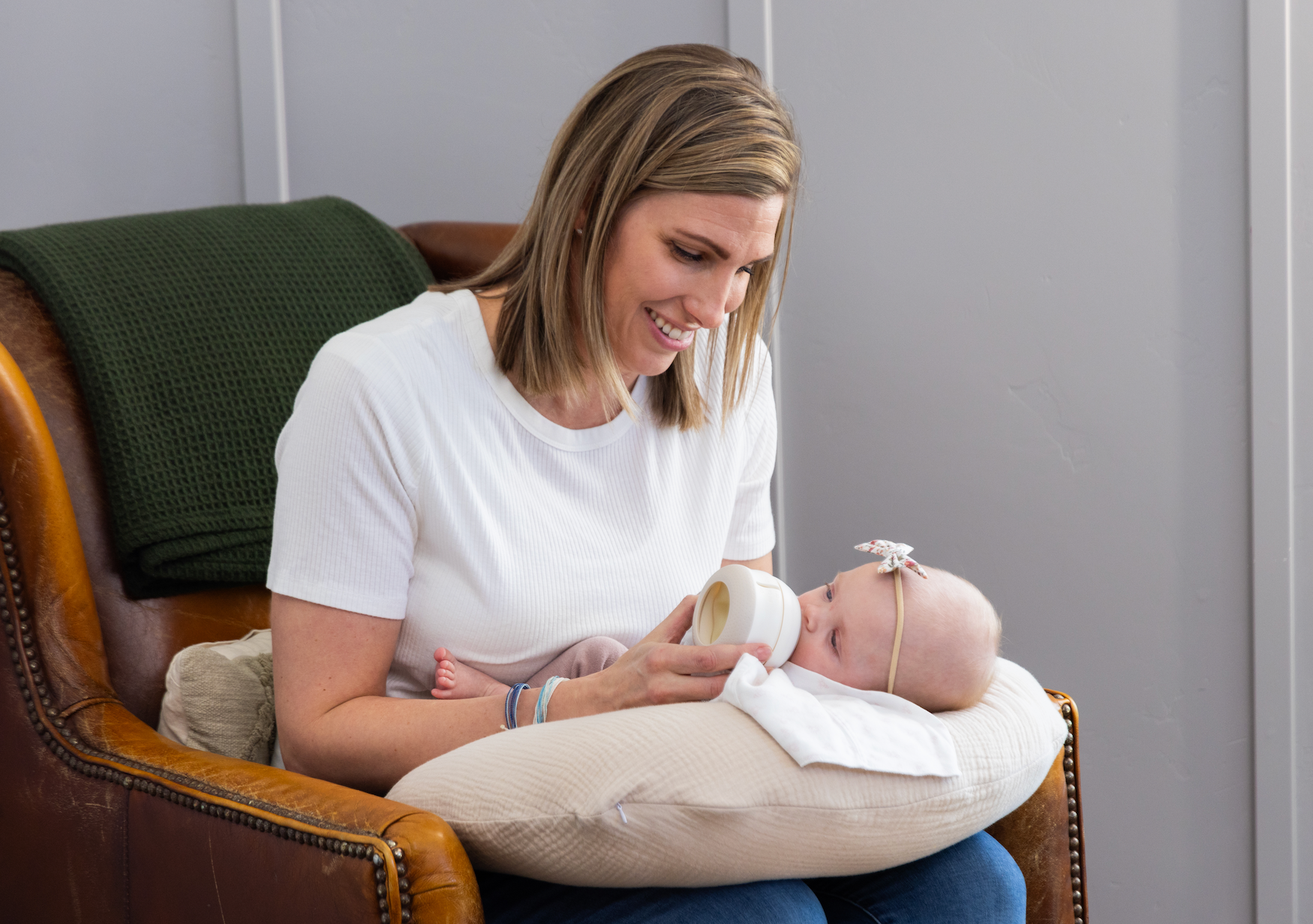Debunking Myths About Bottle Refusal: Understanding and Solving the Real Issues
Introduction:
Did you know that an estimated 25-35% of babies experience some form of bottle refusal? For many parents, this can create anxiety and uncertainty and turn feeding time into a stressful ordeal. Understanding bottle refusal is crucial, as it's not just a baby choosing not to feed; it's a complex issue that is often misunderstood. Let's explore the real definitions and causes behind bottle refusal - and how to address them effectively.
What is Bottle Refusal?
Bottle refusal occurs when a baby stops accepting the bottle. Initially, these babies might have taken a bottle without any issues, making it seem like they are intentionally refusing it. However, this refusal typically begins around 8-12 weeks and can happen gradually or seem to appear from one day to the next.
Difference Between Refusal and Aversion:
When a baby not only refuses the bottle but also becomes upset at its sight, pushing it away or crying, they might be experiencing bottle aversion. "Bottle refusal" simply means a baby is not taking a bottle, while "bottle aversion" indicates a more intense negative reaction to the bottle, often involving distress, crying, or actively turning away due to past negative experiences or sensory issues. Essentially, refusal is a behavior, while aversion is a strong dislike or fear of the bottle itself. This isn't just a preference; it's a sign of deeper discomfort. Common behaviors include pursing their lips, pushing the bottle around in their mouth, thrusting it out with their tongue, or biting on it without sucking. Persistent pushing can lead to crying and distress.
The Truth About Bottle Refusal:
Contrary to popular belief, bottle refusal in babies is often an oral function issue, not something that is driven by "preferences" or something that parents or babies are necessarily doing wrong. Babies are born with instincts and reflexes to eat. They are designed with an innate desire and need to feed. When a baby refuses a bottle, it is often because they genuinely can't and this should be taken as an indicator that something else might be going on. In short, it is essential to look for underlying causes, rather than always attributing the refusal to a behavioral issue.
Myths vs. Reality:
-
Myth: "Let the baby get hungry enough, and they'll take the bottle."
-
Reality: Babies are born with a natural instinct to eat. If they're not feeding, there's a reason that needs addressing, not ignoring.
-
Myth: "Moms should leave the room and shouldn't introduce the bottle."
-
Reality: Sometimes, a trusted relationship with the mom makes her the ideal person to introduce the bottle. Other times, another caregiver might be more effective. Trust your instincts and adapt to your baby's needs.
Understanding Oral Function:
The transition from an involuntary sucking reflex to a voluntary action occurs between 6-12 weeks. During this time, babies must learn to coordinate their tongue's eight muscles to suck, seal, and swallow effectively. While effective latching and the correct suck, swallow, breathe rhythm may happen at the breast, it does not mean it will automatically happen successfully at the bottle. It is quite a complex motor skill once their sucking reflex integrates. For this reason, it is crucial to maximize the window and introduce a bottle when this reflex is present (more on this below).
The Real Cause: Oral Function Issues:
For babies under 6 months old, bottle refusal is most often linked to oral function issues, even if the baby is breastfeeding well and gaining weight. As the sucking reflex transitions from involuntary to voluntary between 6-12 weeks, babies need to learn to coordinate their tongue to suck, seal, and swallow effectively. This complex skill can be hindered by anatomical factors. Things such as tongue or lip ties, thick muscular cheeks, or a high palate, can all impact the effectiveness of a baby's ability to suckle and expel milk. These anatomical factors are often evidenced by issues like a shallow latch, reflux, overactive gag reflex, clicking sounds while eating, frequent choking or coughing, consistent difficulty with latch, or not being able to keep a pacifier in the mouth.
Addressing Bottle Refusal:
It is first important to understand why your baby is struggling with the bottle. Then, work with your little one to guide them through ways to overcome it. Identifying the root cause for your unique baby is essential. Consulting with a lactation consultant or pediatric specialist can help uncover any oral function issues.
What to Do if Your Baby Refuses to Eat From a Bottle:
-
Don’t Force Your Baby to Eat:
Avoid nudging the bottle into your baby's mouth. Forcing can worsen feeding experiences. Patience is key. -
Find Out Why Your Baby is Refusing the Bottle:
Consult a pediatrician to rule out medical reasons for aversion. Specialists like IBCLC’s or Pediatric PT’s or Pediatric OT’s can assess your baby’s unique anatomy and suggest treatments if needed, like exercises or corrective procedures for tongue or lip ties. -
Use the Babaloo Baby-Led Bottle:
Babaloo allows your baby to control their feeding pace and eat in any position that is comfortable to them. This can help them feel more in control and allow them to overcome bottle aversions. -
Change the Feeding Position or Routine:
Adjust feeding routines with relaxing pre-feeding activities to reduce anxiety. Ensure your baby is in a comfortable semi-upright position during feeding. -
Be Patient:
Understandably, dealing with bottle refusal can be stressful, but maintaining a calm and positive environment is crucial. Babies can sense tension, so patience and positivity are vital.
Strategies to Prevent Bottle Refusal In The First Place:
-
Introduce the Bottle Early:
Start a daily practice bottle at 3-4 weeks of age. This is important. If we wait too long, the baby can have difficulty accepting the bottle as reflexive sucking begins to fade and the baby has to choose to participate around 6-12 weeks of age. Bottle feeding is primarily a motor skill that needs to be practiced. To help make the frequency happen, the bottle can replace a full feeding or be just a snack. Offer the bottle during calm times and gradually increase exposure without pressure. Babies have trust with their mothers, so the mother can give the bottle. Using a Babaloo bottle allows your newborn baby to feed in a comfortable position, like sidelying, in their mothers arms, or while laying on a caregiver’s chest. -
Practice Frequently:
Practice frequently with positive interactions with just the nipple. Offer a bottle at least 5 days a week between 3-4 weeks old. This way, you can take advantage of the baby’s sucking reflex and keep up the practice so they can transfer that skill from a reflexive one to an active and learned skill. If they have trouble, break down the skill for the baby. At its core, remember bottle feeding is a motor skill. To further optimize how your baby interacts with the silicone nipple, engage your baby in oral play and exercises using your finger, teethers, and bottle nipples. This introduces different textures without the expectation of eating, helping to strengthen, stretch, and coordinate mouth muscles and improve sensory processing. The Babaloo bottle allows the baby to drink milk in any position so you can make practice fun and interesting. You can switch up the environment and create a playful experience, like practicing while in tummy time. This allows you to practice frequently without your baby getting bored or frustrated. -
Create a Positive Feeding Environment:
Make feeding a calm and comfortable experience in a quiet, familiar setting with eye contact. Feeding is a relationship, and co-regulation can occur in both positive and negative spaces. Aversions can come on quickly, and recovery can be intense. Separating to connect by laying the baby on their side rather than in your arms can sometimes help reset a feeding relationship pattern. Another purposeful position is the biological nursing position that can be achieved with the Babaloo bottle and the baby-led feeding strap. This feeding system is designed to create bonding moments between you and your little one. These moments of connection can make a huge difference in creating a positive environment and feeding associations. -
Address Underlying Issues:
Babies are born with sucking reflexes and are naturally inclined to eat. If they refuse a bottle, it's often due to underlying issues or oral dysfunction. A professional assessment is recommended to identify these issues. Muscle tension or imbalances can create difficulty latching, and oral dysfunctions, such as weak or uncoordinated muscles, can play a big role. There are eight muscles in the tongue that must work together to seal, suck, and pull the nipple to roll the milk to the back and swallow. Oral exercises can improve many dysfunctions, just like any other muscle in the body. If muscles aren't trained before the sucking reflex is integrated, babies may struggle with bottle feeding post-integration. -
Assess Bottle Features:
Things like nipple shape, flow rate, and air bubbles factor into the feeding experience. Finding a bottle that suits your baby's preferences is key. Using a bottle that allows your baby to control the flow rate and eat in any position can give your baby much-needed autonomy and diffuse pressure or tension caused by traditional baby bottles. With the Babaloo bottle, your baby can be in full control. Its baby-led nipple allows your baby to choose a fast or slow flow within a single feeding session. Its gravity-free design allows for babies to eat in any position and hold it with one or both hands. Its airless design allows all the air to be expelled from the milk bag, reducing colic, gas, and spit-up. No other bottle provides as many unique and meaningful features and solutions.
The Role of Babaloo:
Babaloo’s Baby-Led Bottle® is specifically designed to address common causes of bottle refusal. Its soft, ergonomic nipple promotes natural feeding mechanics, while the baby-led flow control and gravity-free design allow babies to feed comfortably in any position, reducing frustration and mimicking breastfeeding.
Key Benefits of Babaloo:
-
Baby-Led Flow Control: Empowers babies to adjust the flow rate, mimicking breastfeeding.
-
Gravity-Free Design: Allows babies to feed in any position, providing flexibility and comfort.
-
Airless Technology: Eliminates air bubbles which can reduce colic, gas and fussiness.
-
Natural Feeding Positions: Supports ergonomic and nurturing feeding setups, enhancing bonding.
Babaloo offers a solution that prioritizes your baby’s comfort and helps make bottle-feeding a positive and intuitive experience.
Conclusion:
Bottle refusal isn't a problem caused by parents, and it's often solvable. By understanding your baby's unique needs and addressing any underlying oral function issues, you can create a positive feeding experience. Identifying the root cause is key, and consulting with a pediatric specialist or lactation consultant can provide valuable insights and solutions. Remember, you're not alone in this journey, and support is available.
Call to Action:
Explore Babaloo’s Baby-Led Bottle® and share your questions or experiences with us—we’re here to support you and your little one on this journey.
